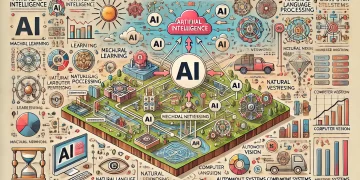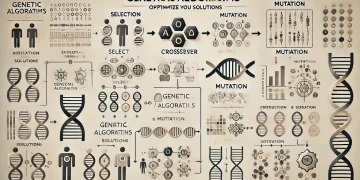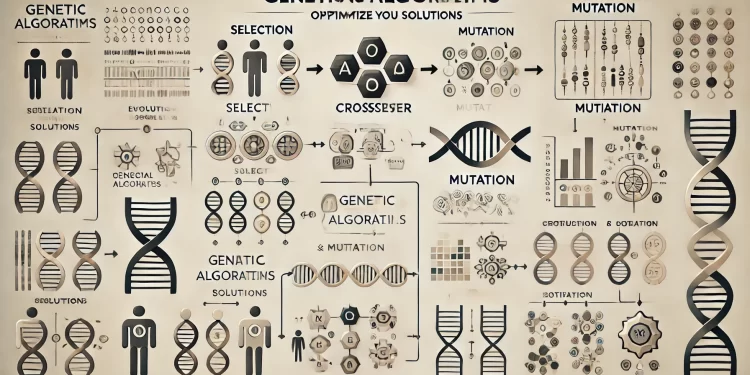Imagine you’re trying to find the best way to deliver products from a large manufacturer to stores. You need to figure out the most efficient delivery routes, the best timing, and how to allocate resources wisely. This is a complex problem with many possible solutions, but a genetic algorithm can help find a good one.
A genetic algorithm is inspired by the way nature selects the strongest individuals for survival. Instead of testing every possible solution (which could take forever), it starts with a group of potential solutions and improves them step by step. Here’s how it works:
- Start with a variety of possible solutions – Different delivery plans are created, each with its own routes and schedules.
- Evaluate how good each solution is – The best ones might be the fastest, cheapest, or most reliable.
- Keep the best solutions and discard the worst ones – Just like in nature, only the fittest survive.
- Mix the best solutions together – Good ideas from different solutions are combined to create better ones. For example, one plan’s fast route could be mixed with another plan’s efficient use of trucks.
- Introduce small changes – Sometimes, small random changes (mutations) help discover even better solutions.
- Repeat the process – Over time, the solutions keep improving until we find one that works well.
This method is useful for solving complex problems where testing every possibility isn’t practical. It’s used in areas like supply chain management, financial planning, and even designing better technology.
One classic example is the Traveling Salesman Problem (TSP). Imagine a salesperson who needs to visit many cities while traveling the shortest distance. As the number of cities grows, the number of possible routes becomes overwhelming.
How the Number of Possible Routes Grows?
If a delivery company needs to visit a set of cities and return home, the number of possible routes increases exponentially as more cities are added.
2 Cities: San Francisco & Las Vegas
Possible routes:
- San Francisco → Las Vegas → San Francisco
- Las Vegas → San Francisco → Las Vegas
Total routes: 2! = 2
3 Cities: San Francisco, Las Vegas, Phoenix
Possible routes:
- San Francisco → Las Vegas → Phoenix → San Francisco
- San Francisco → Phoenix → Las Vegas → San Francisco
- Las Vegas → San Francisco → Phoenix → Las Vegas
- Las Vegas → Phoenix → San Francisco → Las Vegas
- Phoenix → San Francisco → Las Vegas → Phoenix
- Phoenix → Las Vegas → San Francisco → Phoenix
Total routes: 3! = 6
4 Cities: San Francisco, Las Vegas, Phoenix, Denver
Possible routes:
- San Francisco → Las Vegas → Phoenix → Denver → San Francisco
- San Francisco → Las Vegas → Denver → Phoenix → San Francisco
- San Francisco → Phoenix → Las Vegas → Denver → San Francisco
- San Francisco → Phoenix → Denver → Las Vegas → San Francisco
- San Francisco → Denver → Las Vegas → Phoenix → San Francisco
- San Francisco → Denver → Phoenix → Las Vegas → San Francisco
(…and so on…)
Total routes: 4! = 24
With 5 cities, the number of routes increases to 5! = 120
With 8 cities, the number of routes increases to 8! = 40,320
- 9 cities → 9! = 362,880
- 10 cities → 10! = 3,628,800
- 11 cities → 11! = 39,916,800
- 12 cities → 12! = 479,001,600
- 20 cities → 20! = 2,432,902,008,176,640,000
At 20 cities, the number of possibilities is so large that even the most powerful computers would struggle to evaluate them all. This is why genetic algorithms are crucial for solving these kinds of problems efficiently.
Example
Imagine a delivery company needs to visit 8 cities and find the most efficient route. Some merchandise, like perishable goods, need to be delivered to Las Vegas and Cheyenne, and these items must be handled carefully, accounting for time-sensitive delivery. Checking all possible routes is unfeasible, so instead of testing every combination, we use a genetic algorithm to find a near-optimal solution efficiently while considering these special constraints.
Example: Suppose the company needs to optimize the route for these 8 cities:
- San Francisco
- Las Vegas
- Phoenix
- Denver
- Salt Lake City
- Portland
- Boise
- Cheyenne
Step 2: Generate an Initial Population
We create hundreds or thousands of random routes (each route is a different ordering of the 8 cities). Here are 5 random routes:
- Route 1: SF → Boise → Phoenix → Denver → Portland → LV → SLC → Cheyenne → SF
- Route 2: SF → Portland → Boise → Phoenix → LV → Cheyenne → SLC → Denver → SF
- Route 3: SF → Phoenix → Portland → LV → Cheyenne → Boise → Denver → SLC → SF
- Route 4: SF → LV → Boise → Cheyenne → Portland → Phoenix → Denver → SLC → SF
- Route 5: SF → SLC → Portland → Boise → Cheyenne → LV → Denver → Phoenix → SF
- Route 6: SF → Cheyenne → Phoenix → Boise → LV → Denver → SLC → Portland → SF
Remaining Routes: 1000 (assuming we start with 1000 random routes in the initial population)
Step 3: Evaluate Fitness (Scoring the Routes)
- The fitness function calculates the total travel distance for each route.
- Shorter routes score higher, while longer routes score lower.
- Special Consideration: Routes with longer travel times to Las Vegas and Cheyenne, where perishable goods are being delivered, receive a penalty based on how long the perishable goods are in transit.
Example:
- Route 1: 2,500 miles → Lower fitness (due to delayed perishable goods)
- Route 2: 2,100 miles → Higher fitness (perishable goods delivered more efficiently)
Step 4: Selection (Pick the Best Routes)
- The top 25-50% of routes (shortest ones and those delivering perishable goods efficiently) are selected for breeding.
- Lower-ranked routes are discarded.
Step 5: Crossover (Combining Good Routes)
- Two selected routes are combined to create a new route.
- Example:
- Parent 1: SF → LV → Phoenix → Denver → Portland → Boise → SLC → Cheyenne → SF
- Parent 2: SF → Boise → Phoenix → Portland → LV → Cheyenne → SLC → Denver → SF
- Child Route (Mix of Both Parents): SF → LV → Phoenix → Portland → Boise → Denver → SLC → Cheyenne → SF
This method preserves good segments from each parent while introducing variation and ensuring the efficient delivery of perishable goods.
Step 6: Mutation (Adding Random Changes)
- A small mutation (swapping two cities) is applied 5-10% of the time to explore new possibilities.
- Example:
- Original: SF → LV → Phoenix → Denver → Portland → Boise → SLC → Cheyenne → SF
- After Mutation: SF → LV → Phoenix → Portland → Boise → Denver → SLC → Cheyenne → SF
The mutation helps in exploring potential routes where perishable items may be delivered faster.
Step 7: Repeat for Many Generations
- The selection, crossover, and mutation steps repeat hundreds or thousands of times.
- Over time, the routes become shorter and more efficient while ensuring perishable goods are prioritized for timely delivery to Las Vegas and Cheyenne.
- The algorithm converges to a near-optimal solution, balancing both efficiency and perishability constraints.
Final Optimized Route Example
After many generations, the best route might look like this: SF → Phoenix → Denver → Cheyenne → LV → Boise → SLC → Portland → SF
- Total Distance: 1,800 miles (much better than 2,500 miles from random routes!)
- Perishable Goods Consideration: The route prioritizes quick delivery to Las Vegas and Cheyenne, ensuring perishable merchandise arrives on time.
This method allows the delivery company to efficiently find the best route while ensuring perishable goods are handled properly, reducing travel time, and minimizing the risk of spoilage.
Imagine a delivery company that needs to find the best route to visit several cities and return home. Let’s suppose that the goal is to minimize travel distance and cost while ensuring deliveries are made efficiently.
Why Genetic Algorithm Works?
Rather than testing all 40,320 possibilities, the genetic algorithm focuses only on the best solutions and gradually improves them. In just a few hundred generations, it can find a near-optimal route that would have taken too long to discover through brute force.
Where Are Genetic Algorithms Used?
Genetic algorithms are used in many areas to solve complex problems that are hard to tackle with traditional methods. Here are some common examples of where GAs are applied:
- Logistics & Delivery (Amazon, UPS, FedEx):
GAs help companies like Amazon, UPS, and FedEx find the most efficient routes for delivery trucks, reducing travel time and fuel costs. - Transportation Planning (Public Transit, Ride-Sharing):
GAs optimize routes for public transportation systems and ride-sharing services like Uber and Lyft, ensuring vehicles take the most efficient paths to their destinations. - Robotics (Self-Driving Cars, Drones):
GAs are used to optimize movement patterns for robots, such as in self-driving cars and drones, helping them navigate efficiently and safely. - Manufacturing (Assembly Line Optimization):
GAs help improve manufacturing processes by optimizing assembly line scheduling, minimizing downtime, and ensuring tasks are completed in the most efficient order. - Bioinformatics and Computational Biology:
GAs are used to solve problems in biology, such as aligning DNA sequences, predicting protein structures, and studying evolution. - Financial Modeling:
In finance, GAs are used to optimize investment portfolios, balancing risk and return to maximize profits while minimizing losses. - Scheduling Problems:
GAs help schedule tasks in industries like manufacturing, project management, and logistics, minimizing time and costs while meeting constraints, such as worker shifts or machine availability. - Energy Optimization:
GAs are used to design and optimize energy systems, like electrical grids or renewable energy sources, ensuring efficient energy distribution and reducing waste. - Cybersecurity:
In cybersecurity, GAs are used to improve defense strategies, such as evolving intrusion detection systems based on new and emerging threats.
In addition to the examples mentioned above, many other domains also benefit from the flexibility and power of genetic algorithms. Whether it’s for enhancing customer experience, improving product design, or even in entertainment (such as game development or creative processes), GAs continue to provide innovative solutions across a wide range of industries.
Conclusion
Genetic algorithms are valuable tools for tackling complex optimization problems in various fields. Their ability to evolve solutions over time makes them highly effective in situations where traditional approaches would be too slow or computationally expensive.



































